Intel NUC6CAYH (Arches Canyon) Apollo Lake UCFF PC Review
by Ganesh T S on January 12, 2018 8:00 AM EST- Posted in
- Systems
- Intel
- NUC
- UCFF
- Apollo Lake
- Arches Canyon
Performance Metrics - II
In this section, we mainly look at benchmark modes in programs used on a day-to-day basis, i.e, application performance and not synthetic workloads.
x264 Benchmark
First off, we have some video encoding benchmarks courtesy of x264 HD Benchmark v5.0. This is simply a test of CPU performance. As expected, the Celeron J3455 is at the top in both passes. Recent releases of the x264 benchmark can show even more impressive gains, as they make use of the latest and greatest features of the modern Intel processors.


7-Zip
7-Zip is a very effective and efficient compression program, often beating out OpenCL accelerated commercial programs in benchmarks even while using just the CPU power. 7-Zip has a benchmarking program that provides tons of details regarding the underlying CPU's efficiency. In this subsection, we are interested in the compression and decompression MIPS ratings when utilizing all the available threads.


TrueCrypt
As businesses (and even home consumers) become more security conscious, the importance of encryption can't be overstated. CPUs supporting the AES-NI instruction for accelerating the encryption and decryption processes have become more widespread over the last few years. TrueCrypt, a popular open-source disk encryption program can take advantage of the AES-NI capabilities. The TrueCrypt internal benchmark provides some interesting cryptography-related numbers to ponder. In the graph below, we can get an idea of how fast a TrueCrypt volume would behave in the Intel NUC6CAYH and how it would compare with other select PCs. This is a purely CPU feature / clock speed based test.

Agisoft Photoscan
Agisoft PhotoScan is a commercial program that converts 2D images into 3D point maps, meshes and textures. The program designers sent us a command line version in order to evaluate the efficiency of various systems that go under our review scanner. The command line version has two benchmark modes, one using the CPU and the other using both the CPU and GPU (via OpenCL). We have been using an old version of the program with 50 photogaphs in our reviews till now. The updated benchmark (v1.3) now takes around 84 photographs and does four stages of computation:
- Stage 1: Align Photographs (capable of OpenCL acceleration)
- Stage 2: Build Point Cloud (capable of OpenCL acceleration)
- Stage 3: Build Mesh
- Stage 4: Build Textures
We record the time taken for each stage. Since various elements of the software are single threaded, others multithreaded, and some use GPUs, it is interesting to record the effects of CPU generations, speeds, number of cores, DRAM parameters and the GPU using this software.
The GPU turns out to be too weak and is actually detrimental to the performance numbers from the first stage. The second stage's improvement with the GPU enabled is within the margin of error that one encounters from run to run.
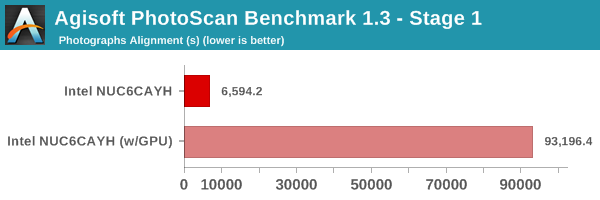
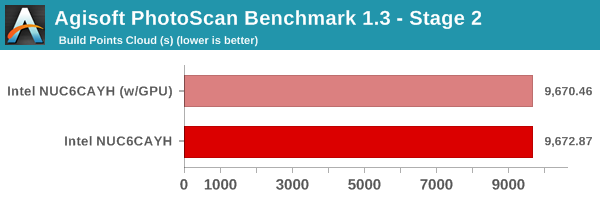
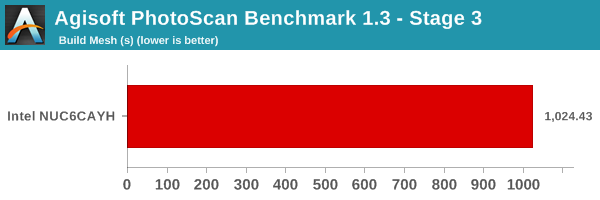
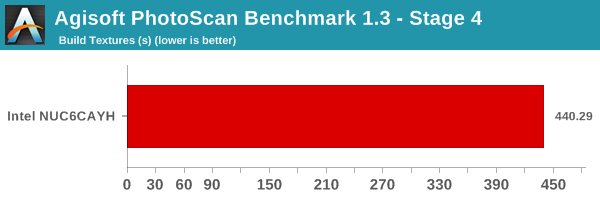
Dolphin Emulator
Wrapping up our application benchmark numbers is the new Dolphin Emulator (v5) benchmark mode results. This is again a test of the CPU capabilities, but, we do not have numbers with other systems to compare against.
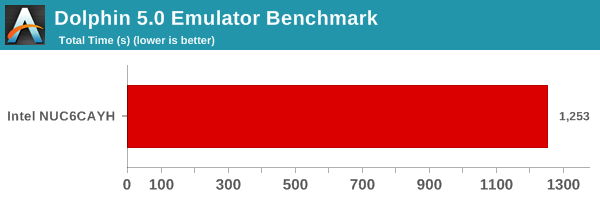










54 Comments
View All Comments
ganeshts - Friday, January 12, 2018 - link
Have you looked at the prices of RAM and flash lately? The Corsair kit was $90 when I was writing this review a week or so back (looks like it is $80 today), and the MX200 is relatively rare to find now (it was $250 when I was writing this). I think the cheapest equivalent today would be the BX300 480GB @ $145. So, the $470 price at the time of writing is probably closer to $355 now.That said, RAM and flash prices are fluctuating wildly due to the recent shortage. Things ought to become stable and a bit cheaper soon.
powellandy - Friday, January 12, 2018 - link
Do you have any comment on the ability to play 3D - looks like it's an ongoing saga with Intel chips -https://communities.intel.com/thread/112109
bill44 - Saturday, January 13, 2018 - link
Been following that thread, which is now dead. Intel won't/can't fix it. If they could, they've done it by now. Not enough customer complained (not to mention, 3D for the industry is dead), as such it just gets dragged out until everyone gives up.Going into the future, native HDMI 2.x may fix the issue, but going by past experience, there will always be problems with a HTPC setup (check out MadVR Madshi forums regarding constant driver issues).
powellandy - Monday, January 15, 2018 - link
I agree, but I was hoping if they mention it in the review and perhaps ask Intel it would put a bit of pressure on them to fix it!bji - Friday, January 12, 2018 - link
Do the benchmarks include Meltdown and Spectre fixes? If they don't, then the numbers are not accurate.ganeshts - Friday, January 12, 2018 - link
The benchmark numbers were processed before the security fixes started coming in. The relative numbers are still accurate when you compare one unit against the other (all of them in the comparison graphs are Intel-based systems).We are waiting for the dust to settle on all security fixes before embarking on any benchmark numbers regeneration procedures.
satai - Friday, January 12, 2018 - link
Some comparison to Core Ms would be nice.fuzzymath10 - Friday, January 12, 2018 - link
It's just "feel" based, but I bought my NUC (the same one + old Intel 320 160GB + 8GB ram + W10 Pro) to play videos on my 4k TV. Before, I temporarily used my Venue 7140 Pro with the 5Y10. The 5Y10 is faster for pretty much any "normal" task such as internet browsing which shouldn't be a surprise. Raw multithreaded might be more similar but the Core M is a smoother overall experience.However, the NUC supports 4k @ 60Hz while the HDMI from my Venue is only good to 30Hz. The NUC IGP can also decode HEVC while the HD 5300 in the Venue cannot, and the 5Y10 is not fast enough to software-decode most HEVC content (neither can the J3455). The Core M is also passively cooled while the NUC is semi-passive (fan can shut off).
Unfortunately, Core M is also very expensive. However, I would say the jump in user experience from the NUC to Core M is greater than from Core M to my desktop (i7 3770).
lilmoe - Friday, January 12, 2018 - link
Call me when Intel is capable of delivering anything remotely equal in terms of video/streaming playback performance and efficiency as my 2 year old Galaxy S7.Such incompetence, what a joke.
Hixbot - Friday, January 12, 2018 - link
Are you kidding? This nuc is leaps and bounds more powerful that your smartphone.